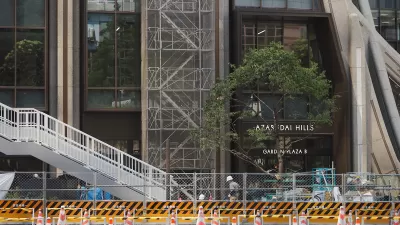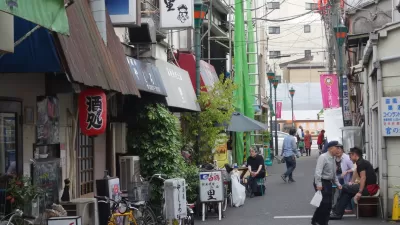Transportation planners who thought the current job climate couldn't possibly get worse may want to ignore this piece. John Metcalfe reports on studies that show slime is just as effective in planning the path of an urban rail system as humans.
In case you needed more convincing that the design of urban rail systems follows some supreme natural order comes this item in The Atlantic Cities. John Metcalfe spotlights the work of "protist-obsessed" scientist Atsushi Tero, who has led research into "the path-finding ways of Physarum polycephalum, the "many-headed slime," which survives by sending out tendrils in all directions in the quest for food."
In one stunning experiment, "researchers arranged little oat flakes on a gel in the same pattern of real cities near Tokyo in the Kanto region.
Then they stimulated a slime mold to grow from the center outward,
connecting with all the delicious Oatvilles in a highly precise and
unappetizing game of connect-the-dots. The whole process took just over a
day, and at the end there was the environs of Tokyo, outlined in ooze. (Abstract and study.)"
Researchers that have been working with slime molds believe they, "can create much more effective networks than even the most advanced technology that currently exists," and argue that, "molds
will one day serve in place of human brains and computers when it comes
to designing networks, whether for public transit or power lines or
something else."
FULL STORY: Mapping Tokyo's Train System in Slime Mold

Planetizen Federal Action Tracker
A weekly monitor of how Trump’s orders and actions are impacting planners and planning in America.

Restaurant Patios Were a Pandemic Win — Why Were They so Hard to Keep?
Social distancing requirements and changes in travel patterns prompted cities to pilot new uses for street and sidewalk space. Then it got complicated.

Map: Where Senate Republicans Want to Sell Your Public Lands
For public land advocates, the Senate Republicans’ proposal to sell millions of acres of public land in the West is “the biggest fight of their careers.”

Orange County, Florida Adopts Largest US “Sprawl Repair” Code
The ‘Orange Code’ seeks to rectify decades of sprawl-inducing, car-oriented development.

Maui's Vacation Rental Debate Turns Ugly
Verbal attacks, misinformation campaigns and fistfights plague a high-stakes debate to convert thousands of vacation rentals into long-term housing.

San Francisco Suspends Traffic Calming Amidst Record Deaths
Citing “a challenging fiscal landscape,” the city will cease the program on the heels of 42 traffic deaths, including 24 pedestrians.
Urban Design for Planners 1: Software Tools
This six-course series explores essential urban design concepts using open source software and equips planners with the tools they need to participate fully in the urban design process.
Planning for Universal Design
Learn the tools for implementing Universal Design in planning regulations.
Heyer Gruel & Associates PA
JM Goldson LLC
Custer County Colorado
City of Camden Redevelopment Agency
City of Astoria
Transportation Research & Education Center (TREC) at Portland State University
Camden Redevelopment Agency
City of Claremont
Municipality of Princeton (NJ)





























